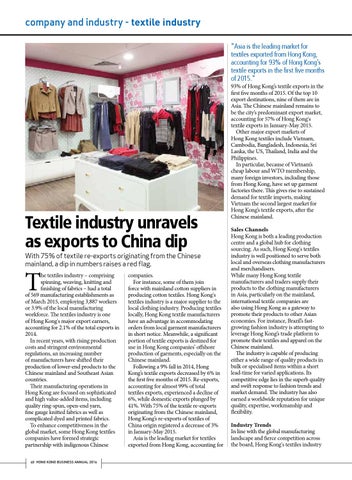company and industry - textile industry "Asia is the leading market for textiles exported from Hong Kong, accounting for 93% of Hong Kong’s textile exports in the first five months of 2015."
Textile industry unravels as exports to China dip
With 75% of textile re-exports originating from the Chinese mainland, a dip in numbers raises a red flag.
T
he textiles industry – comprising spinning, weaving, knitting and finishing of fabrics – had a total of 569 manufacturing establishments as of March 2015, employing 3,887 workers or 3.9% of the local manufacturing workforce. The textiles industry is one of Hong Kong's major export earners, accounting for 2.1% of the total exports in 2014. In recent years, with rising production costs and stringent environmental regulations, an increasing number of manufacturers have shifted their production of lower-end products to the Chinese mainland and Southeast Asian countries. Their manufacturing operations in Hong Kong are focused on sophisticated and high value-added items, including quality ring-spun, open-end yarn, fine gauge knitted fabrics as well as complicated dyed and printed fabrics. To enhance competitiveness in the global market, some Hong Kong textiles companies have formed strategic partnership with indigenous Chinese 40 HONG KONG BUSINESS ANNUAL 2016
companies. For instance, some of them join force with mainland cotton suppliers in producing cotton textiles. Hong Kong's textiles industry is a major supplier to the local clothing industry. Producing textiles locally, Hong Kong textile manufacturers have an advantage in accommodating orders from local garment manufacturers in short notice. Meanwhile, a significant portion of textile exports is destined for use in Hong Kong companies’ offshore production of garments, especially on the Chinese mainland. Following a 9% fall in 2014, Hong Kong’s textile exports decreased by 6% in the first five months of 2015. Re-exports, accounting for almost 99% of total textiles exports, experienced a decline of 6%, while domestic exports plunged by 41%. With 75% of the textile re-exports originating from the Chinese mainland, Hong Kong’s re-exports of textiles of China origin registered a decrease of 3% in January-May 2015. Asia is the leading market for textiles exported from Hong Kong, accounting for
93% of Hong Kong’s textile exports in the first five months of 2015. Of the top 10 export destinations, nine of them are in Asia. The Chinese mainland remains to be the city’s predominant export market, accounting for 57% of Hong Kong's textile exports in January-May 2015. Other major export markets of Hong Kong textiles include Vietnam, Cambodia, Bangladesh, Indonesia, Sri Lanka, the US, Thailand, India and the Philippines. In particular, because of Vietnam’s cheap labour and WTO membership, many foreign investors, including those from Hong Kong, have set up garment factories there. This gives rise to sustained demand for textile imports, making Vietnam the second largest market for Hong Kong’s textile exports, after the Chinese mainland. Sales Channels Hong Kong is both a leading production centre and a global hub for clothing sourcing. As such, Hong Kong's textiles industry is well positioned to serve both local and overseas clothing manufacturers and merchandisers. While many Hong Kong textile manufacturers and traders supply their products to the clothing manufacturers in Asia, particularly on the mainland, international textile companies are also using Hong Kong as a gateway to promote their products to other Asian economies. For instance, Brazil’s fastgrowing fashion industry is attempting to leverage Hong Kong’s trade platform to promote their textiles and apparel on the Chinese mainland. The industry is capable of producing either a wide range of quality products in bulk or specialised items within a short lead-time for varied applications. Its competitive edge lies in the superb quality and swift response to fashion trends and market demand. The industry has also earned a worldwide reputation for unique quality, expertise, workmanship and flexibility. Industry Trends In line with the global manufacturing landscape and fierce competition across the board, Hong Kong's textiles industry
